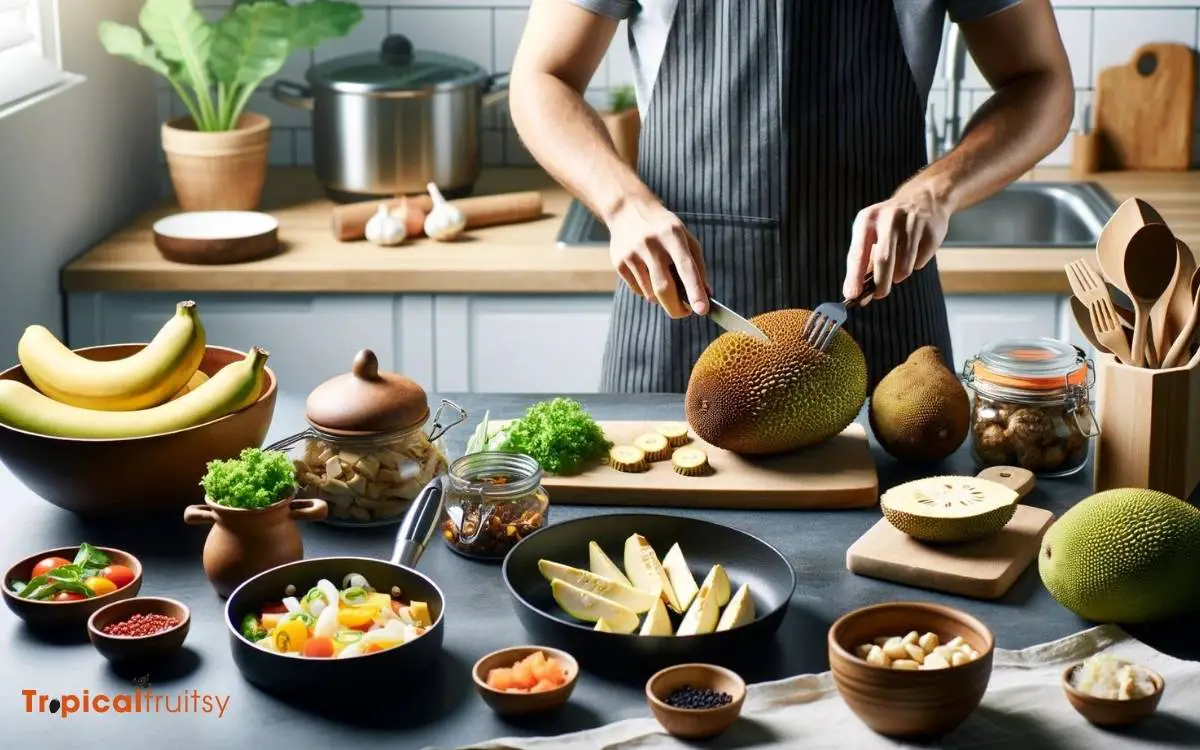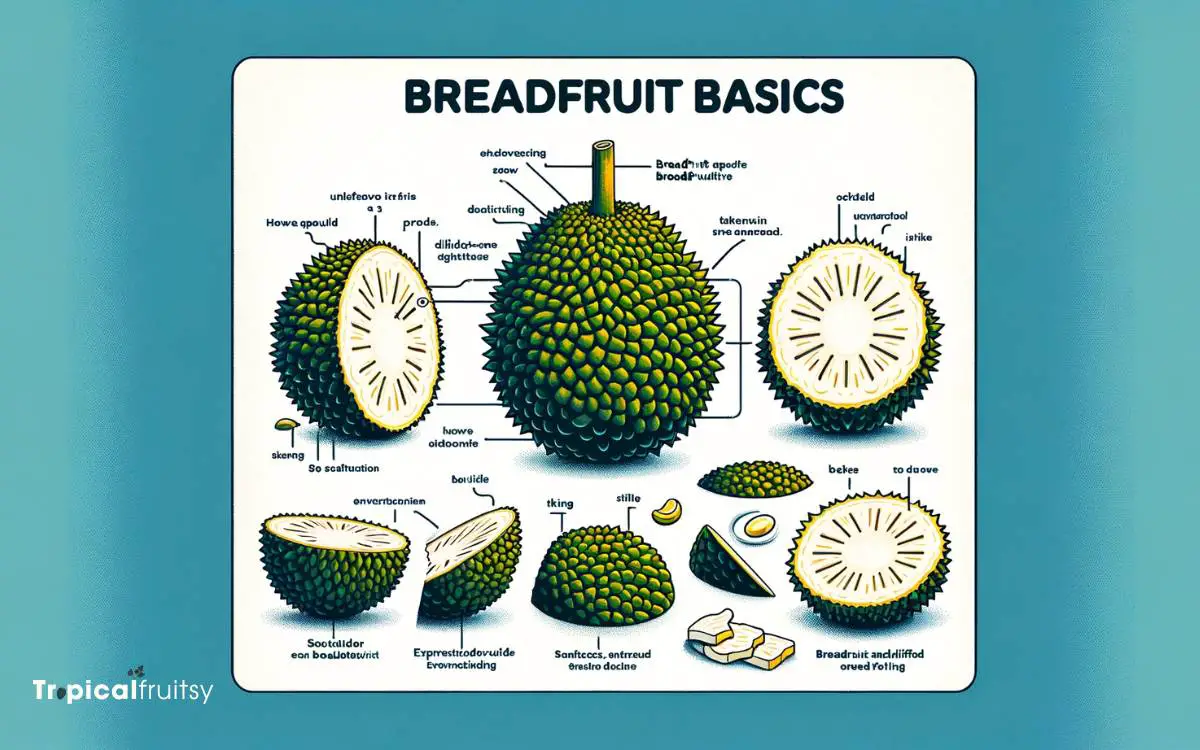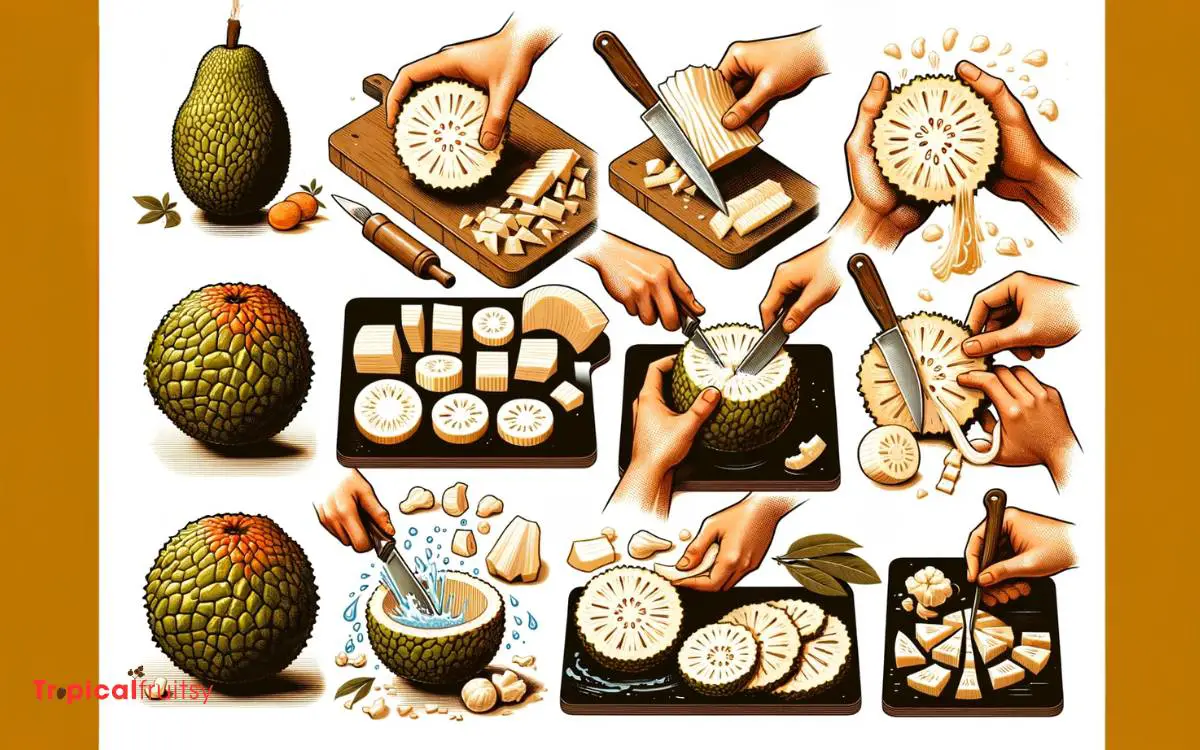What to Do with Breadfruit? Explore!
Breadfruit, a versatile tropical staple, is gaining culinary recognition for its remarkable adaptability in various dishes.
Originating from the Pacific Islands, this starchy fruit offers a plethora of preparation options, appealing to a broad range of palates.
When approaching breadfruit, it is essential to understand its properties and preparation methods to fully harness its potential.
The fruit can be utilized as a substitute for potatoes, incorporated into both savory and sweet culinary creations.
This introduction will guide you through the initial steps of preparing breadfruit, from selecting the perfect ripeness to mastering the techniques of baking, frying, and including it in soups and stews.
We will also explore innovative ways to integrate breadfruit into desserts, as well as methods for its preservation and storage, ensuring that this nutritious fruit can be enjoyed year-round.

Key Takeaway
Breadfruit Culinary Inspiration: Unleash Your Creativity
| Culinary Idea | Description |
|---|---|
| Breadfruit Curry | Create a flavorful curry using breadfruit chunks. |
| Breadfruit Fries | Cut into strips, season, and fry for a crispy snack. |
| Breadfruit Chips | Thinly slice and deep-fry for crunchy chips. |
| Breadfruit Salad | Add chunks of breadfruit to fresh salads. |
| Breadfruit Puree | Mash or puree for a creamy side dish. |
| Breadfruit Soup | Use in soups for added texture and flavor. |
| Breadfruit Desserts | Incorporate into puddings, pies, or cakes. |
| Breadfruit Tacos | Substitute for meat in taco fillings. |
| Breadfruit Stew | Include in hearty stews for a unique twist. |
| Breadfruit Baking | Use breadfruit flour in baking recipes. |
| Breadfruit Smoothie | Blend with fruits for a tropical smoothie. |
| Breadfruit Ice Cream | Make a creamy breadfruit-flavored ice cream. |
Understanding Breadfruit Basics

Discover the versatile breadfruit, a starchy tropical staple that lays the foundation for a myriad of culinary creations.
Originating from the lush rainforests of New Guinea, breadfruit, or Artocarpus altilis, has propagated throughout the Pacific Islands and the tropics worldwide.
This round, green, and bumpy-skinned fruit exemplifies a carbohydrate-rich food source, containing a significant amount of dietary fiber, vitamins, and minerals.
Its utilization is vast; it can be consumed at all stages of maturity. When unripe, its high starch content makes it akin to a potato, suitable for boiling or baking. As it ripens, the starches convert to sugars, offering a sweeter taste suitable for desserts.
Breadfruit’s composition and potential as a sustainable crop have captured the interest of food scientists and agriculturists globally.
Preparing Breadfruit for Cooking

How does one properly prepare breadfruit for cooking to ensure the best culinary results? The process is methodical and requires attention to detail to optimize the texture and flavor of the final dish.
Inspection and Washing: – Select a breadfruit that is firm to the touch with a green to yellowish skin. – Rinse the exterior under cold water to remove any dirt or debris.
Cutting and Core Removal: – Slice off the stem and base to create stable cutting surfaces. – Quarter the breadfruit, then carve out the spongy core and remove the seeds.
Preparation nuances may vary slightly depending on the ripeness of the fruit and the intended cooking method, whether it be roasting, frying, or boiling.
Breadfruit as a Potato Substitute

Moving on to its culinary versatility, breadfruit serves as an excellent substitute for potatoes in a variety of dishes due to its similar texture and flavor profile when cooked.
Its starchy composition allows it to absorb flavors well, making it a suitable alternative in recipes such as mashed dishes, fries, or stews.
Nutritionally, breadfruit is rich in complex carbohydrates and provides a moderate amount of fiber, vitamins, and minerals. Its lower glycemic index compared to potatoes can be beneficial for managing blood sugar levels.
Baking Breadfruit Dishes

Breadfruit lends itself well to baking, opening up a realm of possibilities for creating hearty, nutritious meals and snacks.
When baked, its starches transform, offering a texture that is both suitable for savory dishes and sweet preparations.
Here’s an analytical breakdown of baking breadfruit:
Utilization in Savory Dishes:
- Casseroles: Breadfruit can be used as the primary starch, absorbing flavors from accompanying ingredients.
- Gratins: Sliced and layered with cheese and herbs, it provides an excellent base for a gratifying dish.
Application in Sweet Treats:
- Breadfruit Pudding: Enriched with spices and baked until custard-like consistency.
- readfruit Cakes: Pureed breadfruit incorporated into cake batter for moisture and subtle sweetness.
Each approach harnesses the fruit’s versatility, enhancing its inherent qualities through the application of precise baking techniques.
Frying Techniques for Breadfruit

Frying breadfruit requires precise temperature control to ensure the flesh cooks thoroughly without absorbing excessive oil.
Uniform slicing of the fruit is critical for even cooking and achieving a consistent texture and flavor across all pieces.
These techniques collectively enhance the culinary experience by optimizing the breadfruit’s natural taste and providing a desirable golden-brown finish.
Oil Temperature Control
Mastering the oil’s temperature is crucial when frying breadfruit to ensure a golden, crispy exterior without undercooking the interior.
The ideal oil temperature for frying breadfruit is typically between 350°F to 375°F (175°C to 190°C).
Maintaining this temperature range is vital for several reasons:
- Consistent Cooking: Prevents soggy or overly greasy results and ensures the breadfruit cooks evenly throughout.
- Food Safety: Reduces the risk of foodborne pathogens, which can thrive in undercooked areas, and achieves the necessary thermal processing needed for safe consumption.
Monitoring the oil temperature with a calibrated thermometer is an analytical approach to achieving the desired culinary outcome.
Slicing for Even Cooking
Transitioning from oil temperature control, proper slicing techniques are fundamental to achieving uniform cooking when frying breadfruit.
Uniform slices ensure that each piece of breadfruit cooks at the same rate, preventing some slices from becoming overly browned while others remain undercooked. To achieve this, begin with a sharp knife to obtain clean cuts and avoid bruising the flesh.
Slices should be consistent in thickness, ideally between 1/4 to 1/2 inch, to balance the crisp exterior with a fully cooked interior.
Additionally, uniform slicing increases surface area exposure, allowing for better heat penetration and a more desirable texture upon frying.
Mastering the slice is a precursor to integrating breadfruit into a myriad of dishes, including its role in soups and stews.
Breadfruit in Soups and Stews

Incorporating breadfruit into soups and stews can significantly enhance their texture and nutritional profile.
As a complex carbohydrate with a low glycemic index, breadfruit contributes sustained energy, making it a healthful addition to such dishes.
It acts as a thickener due to its high starch content, offering a creamy consistency without the need for added fats or thickeners.
Nutritional Benefits:
- Rich in dietary fiber, promoting digestive health.
- Contains essential vitamins such as vitamin C and B-complex vitamins.
Culinary Advantages:
- A versatile ingredient that absorbs flavors well.
- Provides a meaty texture, which can be especially appealing in vegetarian or vegan recipes.
Analyzing its role in soups and stews reveals that breadfruit is not only a hearty ingredient but also a canvas for a variety of seasonings and culinary styles.
Sweet Breadfruit Desserts

How can the versatile breadfruit be transformed into delectable sweet desserts?
Upon reaching maturity, breadfruit’s starchy content and subtle sweetness provide an excellent base for various confectioneries.
By incorporating breadfruit into desserts, it not only imparts a unique flavor but also enhances the nutritional profile with its rich fiber, vitamin, and mineral content.
Techniques such as roasting or boiling breadfruit can soften its texture, making it suitable for purees or mash, which can then be integrated into puddings, pies, and cakes.
The addition of spices like cinnamon, nutmeg, and vanilla complements the fruit’s natural sweetness, while caramelization processes can unlock deeper flavors.
Innovatively, breadfruit flour can be used to create gluten-free dessert options, expanding its application in contemporary sweet treat preparations.
What Are Different Ways to Use Breadfruit in Cooking?
There are several delicious ways of cooking breadfruit Jamaican style. You can slice and fry it to make crispy chips, boil and mash it as a side dish, or roast it whole for a unique nutty flavor. Additionally, you can also use breadfruit in stews and curries for a rich, creamy texture.
Preserving and Storing Breadfruit

While breadfruit serves as an excellent ingredient in a variety of sweet desserts, its perishable nature necessitates proper preservation and storage techniques to maintain its quality and extend its shelf life.
Refrigeration:
- Ripe Breadfruit: Store in a refrigerator for up to 2 days to slow down ripening.
- Unripe Breadfruit: Keep at room temperature until ripened, then refrigerate.
Freezing:
- Pre-cooked Slices: Blanch slices and freeze for up to 3 months.
- Puree: Breadfruit puree can be frozen in airtight containers.
Implementing these techniques requires careful attention to the fruit’s ripeness and preparation before storage.
Monitoring temperature conditions and using appropriate containers are critical to prevent spoilage and preserve the breadfruit’s texture and flavor.
Conclusion
Breadfruit serves as a versatile culinary asset, much like a chameleon adapting to its environment.
It can be expertly transformed to substitute for potatoes, incorporated into an array of savory dishes, or sweetened for delightful desserts.
The breadth of techniques from baking to frying enhances its utility. Proper preservation methods ensure its longevity, allowing for sustained use.
The multifaceted breadfruit, when understood and utilized effectively, becomes an indispensable staple in diverse gastronomic practices.






